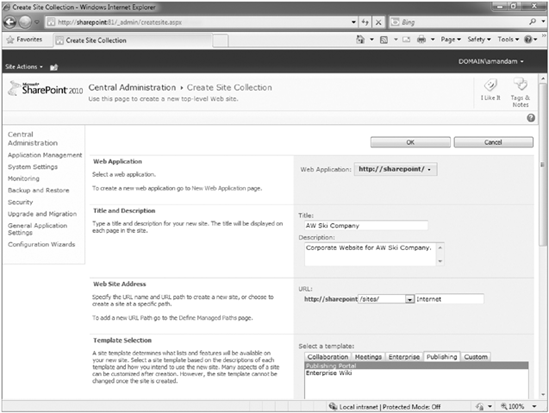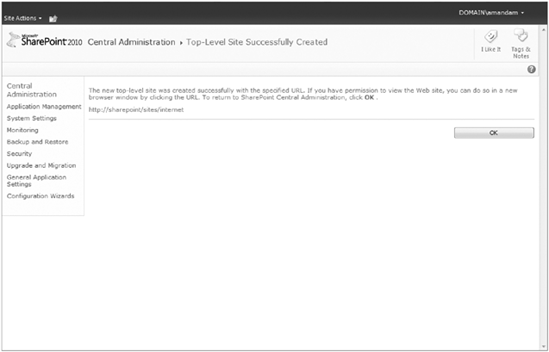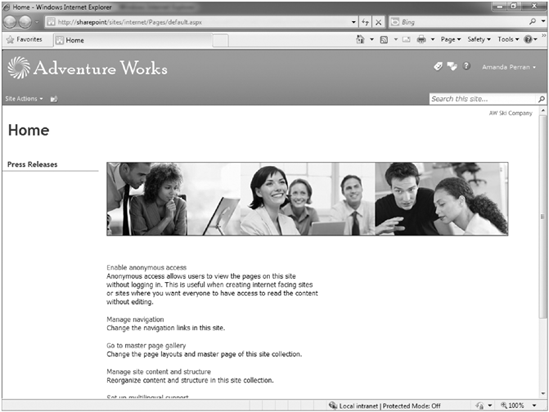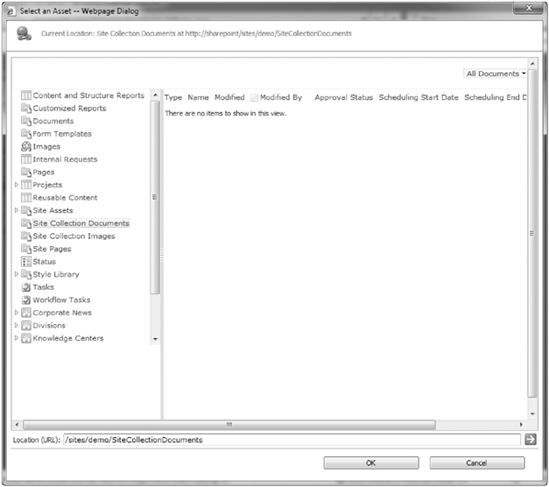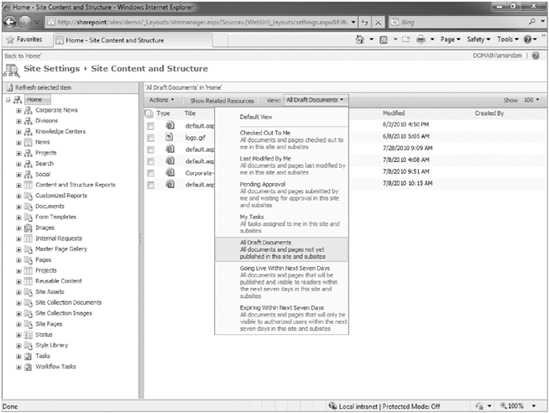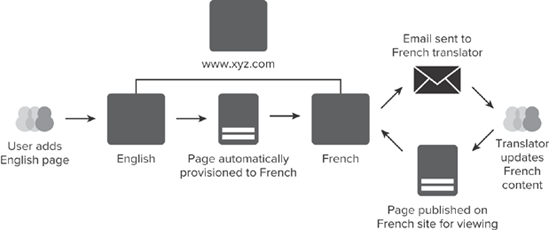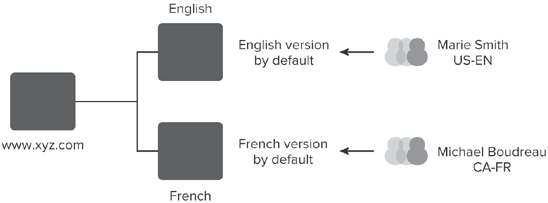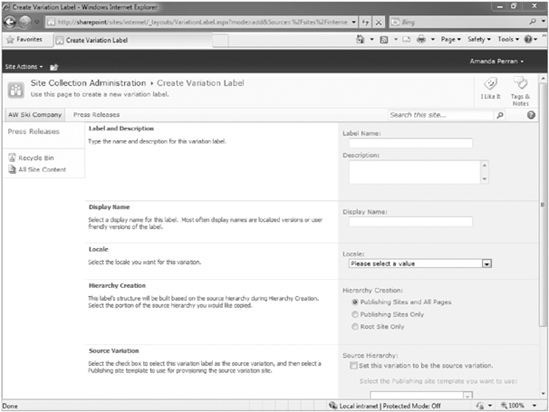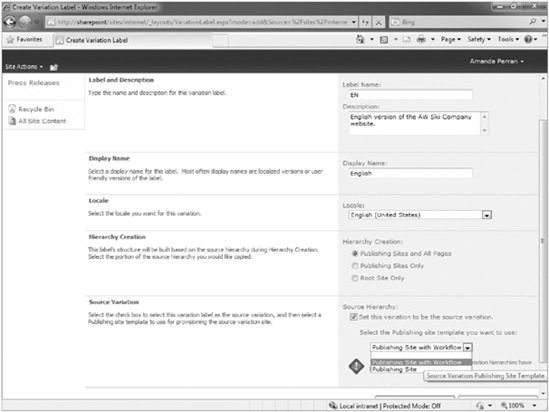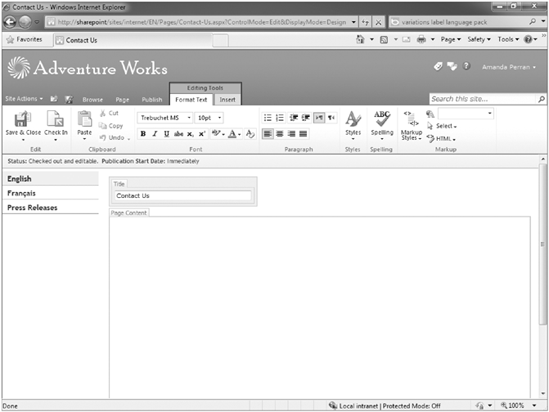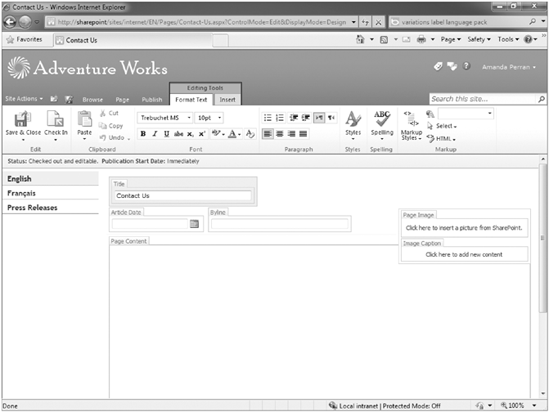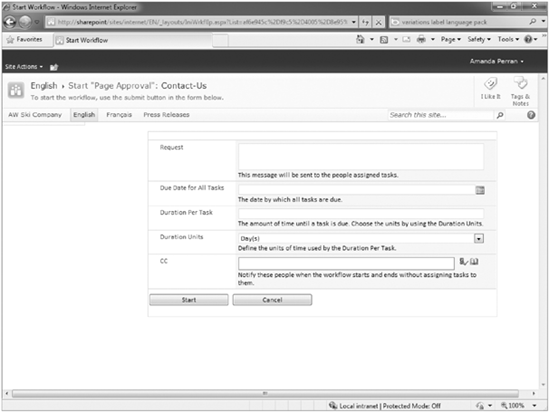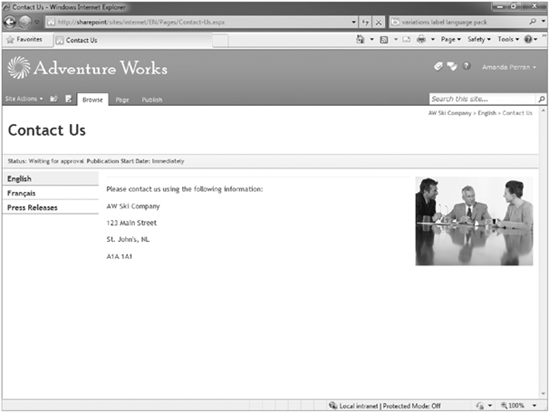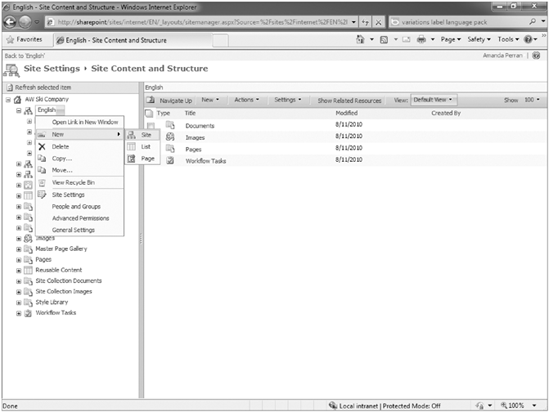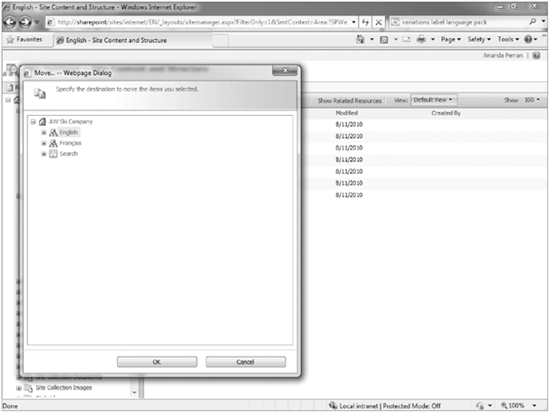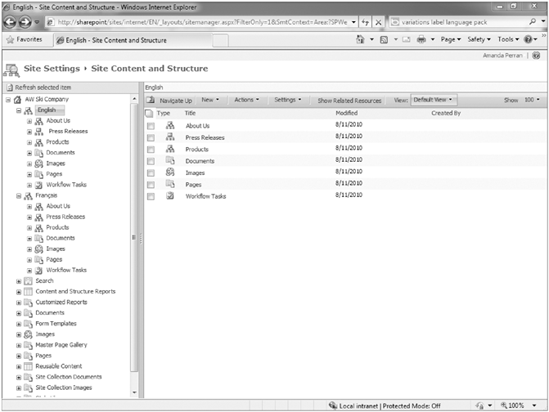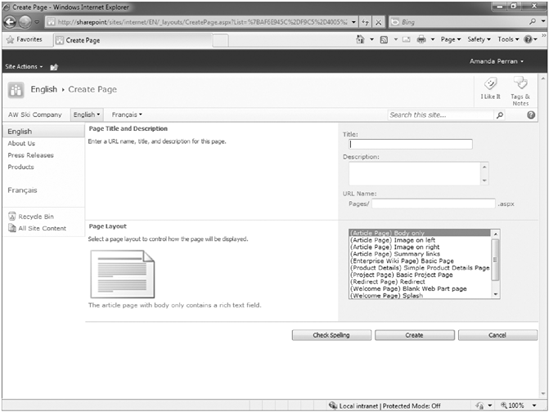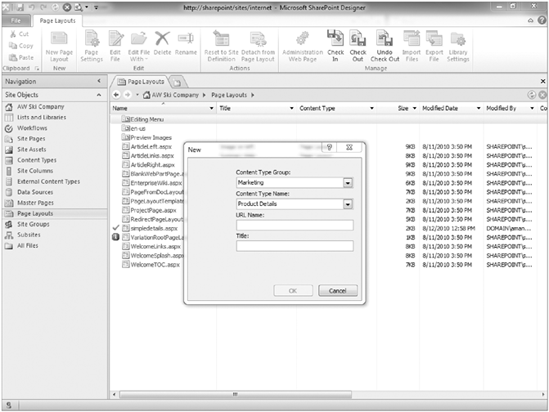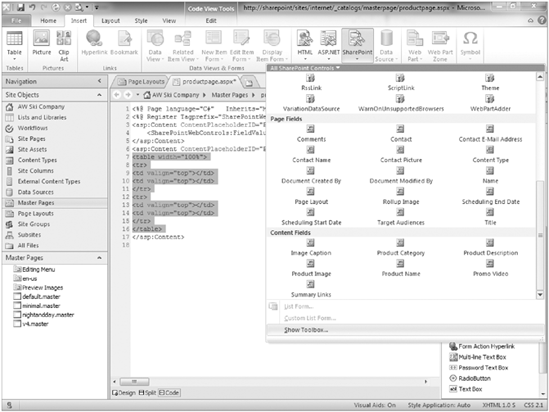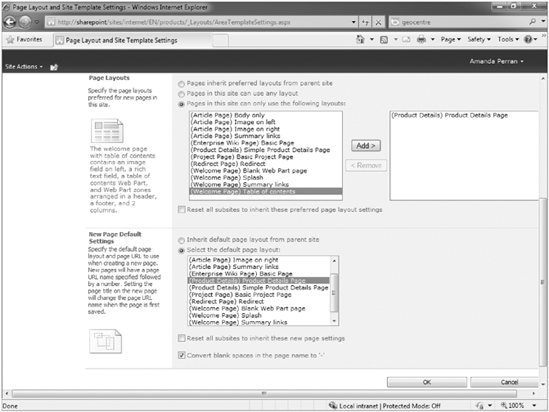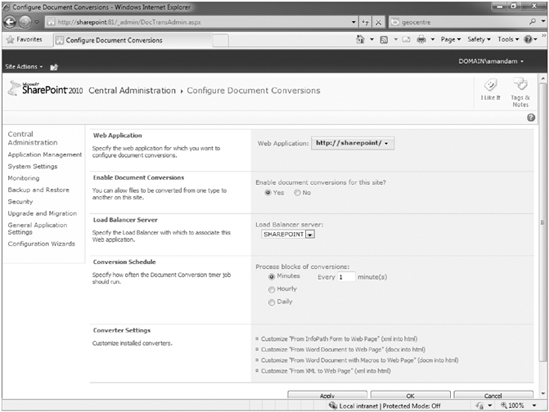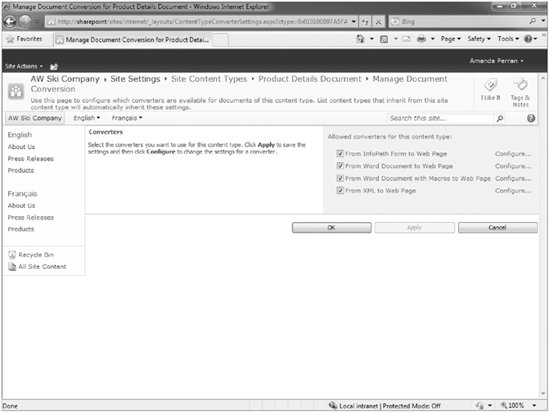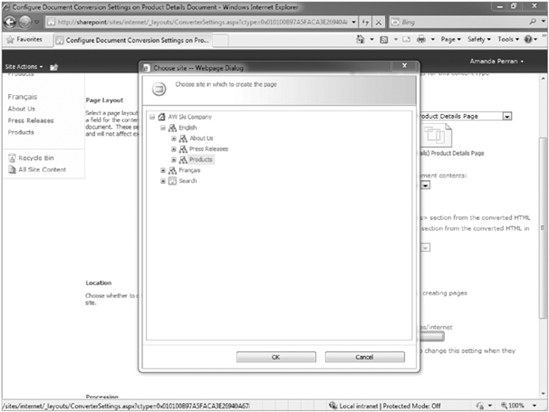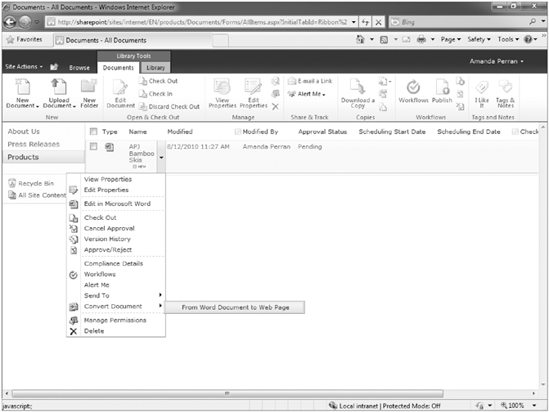WHAT YOU WILL LEARN IN THIS CHAPTER:
What is web content management?
How to use sharePoint to publish web content in a single or multiple languages
How to create custom page layouts and templates
With more and more business activities taking place online, web content management (WCM) has become increasingly important for businesses. WCM is the process of creating and managing web content either on the Internet or an intranet. Where possible, a good web content management system should support a variety of information and provide tools to users for updating this content with minimal effort.
In the past, a major roadblock to managing web content has been the lack of effective tools, which meant relying on expensive, labor-intensive, and time-consuming processes. You don't have these roadblocks using a web content management system such as SharePoint, however. In this chapter, you take a look at WCM and how SharePoint 2010 can make business teams and processes more efficient.
A traditional challenge in many organizations has been the reliance of business users on technical teams to publish new content and to improve communication with stakeholders on the web. SharePoint 2010 makes business users more independent in their content publishing activities, which empowers them to more effectively publish up-to-date information and communicate with their target audience through their website.
So, how can WCM work in your situation? If your company headquarters is in one part of the world, with support teams in other locations, your employees can still collaborate by accessing a company website, regardless of location. Website content owners create lists and libraries and supply employees with the materials they need to perform their day-to-day duties. Managers can create and update a tasks list that outlines what the team needs to do and who is responsible. Teams everywhere can log in to the portal and instantly access important information or even create it for someone in another country. Employees can create email alerts on the important lists and libraries so that colleagues are instantly notified of new or changed content. Specifically, SharePoint has the following features for managing and publishing content:
Page layouts and master pages: Enforce consistency across your website and ensure that all new pages that are created follow your corporate brand.
Creating web pages from the browser: Allows users without knowledge of HTML code to create web pages that inherit the site's look and feel.
Workflows: Automate the process of publishing or approving content. For example, you might create content for a website and then send it through a workflow system where it is approved and finally published to your website.
Content versioning: Ensures that you are always using the most up-to-date versions of your documents and allows you to restore to a previous version by keeping an electronic paper trail as the document evolves.
Reporting dashboards: This is a great way to get a high-level overview of your content.
Check in/check out: Ensures that multiple people are working on the same up-to-date content so that you can check out and in your documents during editing.
Publishing refers to the act of creating content such as a new page in your site or modifying content such as a block of text or a picture. By using built-in publishing tools explained throughout this chapter, you can quickly and easily modify your web content without the need for code. With SharePoint's Publishing feature, you can publish web content for pages and run content approval workflows directly from the browser or use tools like the Enhanced Text Editor to edit text right on the page. SharePoint has various templates, such as the Publishing Portal, that have the Publishing feature already enabled. However, you can enable the Publishing feature on a regular team site, such as a blank site, at any time to give it the publishing capabilities.
If you are planning to create a site that is going to be highly customized and feature many pages of content, you may select the Publishing Portal as the site template for your site collection. You can only select this template as a top-level site within a site collection. In the next Try It Out, you create a Publishing Portal that acts as a sample site for the remainder of this chapter.
As mentioned in the last Try It Out, a publishing portal comes with lists and libraries to get you started, including the ones shown in the following list. In addition to these lists, the site collection contains two subsites for Press Releases and Search. You can create new subsites to represent the various sections of your company website. So, although you may think of a company website as a single site, in fact, it contains multiple subsites. As you create each subsite, the navigation updates to reflect your changes. The navigation controls allow visitors to your site to browse the various sections in a seamless and intuitive manner that does not make them feel as though are actually visiting multiple sites.
Customized Reports: This document library has the templates to create Web Analytics custom reports for the site collection.
Documents: This library stores documents and files to which your website's various content pages link. You can add columns, content types, or views to suit your specific requirements. By default, this library has versioning and content approval enabled, as well as columns for the publishing start and end dates. A version of this library is created in each publishing subsite for files and documents unique to that site.
Form Templates: Chapter 12 discussed how to publish InfoPath Form templates to a site collection as a Content Type or Administrator Approved Template. This is a useful location for storing central templates used by InfoPath forms utilized throughout your site collection.
Images: This system-generated library stores images for display in the current site that has versioning and content approval enabled. A version of this library is created in each publishing subsite for images unique to the site.
Pages: This holds the various pages you create for the content of your website, including the default page. It has a series of special content types that allow you to create site content and pages. Only one pages library can exist within a single site; however, each subsite will have its own version of this pages library.
Site Collection Documents: This document library acts as a centralized store for documents and files that are required and accessed throughout the site collection. Various publishing controls, such as the Enhanced Text Editor or Publishing hyperlink, can access documents in this library. You can select Site Collection Documents from the left menu when editing either of these controls, as shown in Figure 13-4.
Site Collection Images: This document library stores the images that a site collection requires. Like the site collection documents library, this is available directly via the interface when you use the various image publishing controls.
Style Library: This system-generated library contains many of the style elements that your site requires, including custom XSL styles and CSS files; however, you can also add your own style sheets, which you can reference from within the site collection. It is considered a best practice to store any of the branding files related to your site within this library.
Content and Structure Reports: This system list contains special queries within each list item that help to generate the reports available on a publishing site from the Manage Content and Structure section of the site. Reports are helpful for identifying tasks and content that exists throughout the publishing site collection. An example of such a report is shown in Figure 13-5.
Reusable Content: You may need to display content in multiple web parts or locations that are pulled from a single centralized source. This system-generated list contains content that you can display within specific web parts. You can opt to link it back to the source so that as content updates in the list, the areas within the site that are using this content will also automatically be updated.
Workflow Tasks: This system-generated task list tracks the workflow tasks that are created as a result of the various publishing workflows.
In addition to the seamless navigation experience that SharePoint offers users between sites, it also has support for creating portals in multiple languages. In the next section, you see how to take a company website and configure it so that content users can view it in multiple languages.
When you design an Internet-facing website or corporate intranet, you may need to present it in multiple languages. This may simply mean providing users access to documents in multiple languages, or you may need all your content, including web pages and interface elements, in multiple languages. In the latter case, if your content is in one language, such as English, you must translate documents into other languages, but the system should support and manage this process.
SharePoint has the Variations feature, which you can use to create a website hierarchy for content in multiple languages. For example, the site may be where customers from multiple languages can view information about the company's products and services, or a corporate intranet site where employees live in different regions of the world and need access to information in their primary languages. Although Variations does not actually translate the content for you, it starts a workflow that helps you do this work. Basically, you create content in a source language and then provision the content out to other sites, which represent the other required languages. This happens via workflow, which also notifies appropriate users that they are required to perform the translations. Figure 13-6 represents a site hierarchy with support for English and French versions of the website. Besides English and French, Variations can support any other languages, such as Spanish, Japanese, and German.
In this section, you learn how Variations work, including how to enable this feature. You then learn how to create labels for each language on your site, and then how to manage the workflow so that you have all the pieces you need for a working site with multiple language pages.
After login, the version of the site that users see is determined by their preferred language setting in their browser, as shown in Figure 13-7. If, for some reason, a user has a requirement to change the site language to something other than his or her default language, he or she may do so using the global navigation or a language selection control. If that page does not exist or is not published yet, the user is directed to the next page in the site hierarchy, which is typically the parent page.
For a site to become available in multiple languages, you must first enable the Publishing feature. By default, the Publishing Portal has this feature enabled. Enabling variations on a Publishing site, site collection is fairly simple in comparison to the benefit and functionality it provides an organization. In the next example, you configure a site collection to support this feature. You use the Ski Company site for this example.
In Variations, you create a label for each language you want to represent within the site collection. The label defines the language of the site, the display name, the locale, as well as the hierarchy and source hierarchy.
Label name and description: These values are for organizational purposes only. It is important to be descriptive when entering a description for your label so that it is clearly understood by all site administrators.
Display Name: You next define the display name for each site hierarchy. This is the name as it displays in the navigation menu. You generally make the display name the name of the language as it would appear to native speakers, so that they can recognize it and select it. For example, for the French display name, you enter Français, which is the word for "French" in the French language. This is particularly helpful for viewing the structure of the site in reports such as the Manage Content and Structure Report shown in Figure 13-9.
Locale: This further tailors your site to reflect the nuances in variations on the same language. For example, you can define whether your French-speaking audience is French Canadian or from France. Likewise, you can distinguish between an English speaker from the United States and a speaker from Great Britain.
Hierarchy Creation: For each language you want to represent on your website, a subhierarchy is created below the root site.
Source Variation: You must choose the main language for your variations. This will be the initial language in which all content is created before translation and should be based on the majority of your user's first language.
To ensure that pages are translated into the required language of the destination sites as they are created, you can tie your site to a special workflow. As the last section showed, pages are automatically created in the language of the source site. The process works something like this: you create content for the source language page. When you check the page in, this automatically launches an approval process. The group that is to approve the page is automatically notified and a task is assigned in their task list. When the source language page is approved, Variations automatically creates the pages for other languages, and email notifications are sent to translators notifying them that new content has been added to their sites. They translate the page to the appropriate language and, upon checking in the page, start a second approval process.
This section features three Try It Outs that show you the inner workings of the workflow. In the first Try It Out, you create a new page in the source site, which is English. The page is created in the French site, and both sites go through the content editing and approval stages. In the second Try It Out, you create the site's hierarchy by adding a series of subsites that reflect the two main sections of the website: About Us and Products.
Finally, in the third Try It Out, you move the Press Releases site from the root structure of the site into the English version of your site. Once you do this, SharePoint automatically creates a French version of the Press Releases site, just as it did with the Products, About Us, and Custom Contact page from the first and second Try It Outs.
Page layouts control the type of content that can be created on a page as well as where and how that content is displayed. Page layouts are built on content types, which were discussed in Chapter 6. A content type has one or more metadata columns associated with it, and these metadata columns ultimately control the type of information associated with that particular content type, things such as rich HTML fields or images. You can also place web part zones on the page to allow for web part placement.
You define page layouts either through Microsoft Office SharePoint Designer 2010 or via the browser. By default, when you use the browser method, which is described in the first Try It Out in this section, the controls are all added to the page from the top down, stacked one after another, with little control over how the various controls on the page are presented or positioned.
When you require full control over the layout of the page, you can use SharePoint Designer 2010 to create the page layout. If you are comfortable editing a page in SharePoint Designer, you can get started by following the steps in the second Try It Out in this section.
Because SharePoint Designer 2010 is required, it's recommended that only experienced web developers or professionals attempt this type of customization.
In the final Try It Out, you learn how to create a custom page based on your new layout.
Many organizations create and store a great deal of information in popular file formats, such as Word or InfoPath. Because the information already exists in a format with which users are familiar, it does not always make sense to repeat the authoring process when this content needs to go on a website. Instead, it's faster to create web content directly from these files. Further, if you present this content within the corporate website, you would want to maintain the corporate look and feel. SharePoint supports a document conversion feature that allows users to create web pages of content directly from specific file types. SharePoint supports document conversion for the following formats:
In addition, developers can write their own converters and install them. This becomes relevant only if you have a large amount of data in files on your SharePoint server that you want to make available as web content, while avoiding the publishing and duplication processes.
Before you can convert a document, which you do directly from the document libraries, you must first configure this service and then enable the feature via the Central Administration site, which are the subjects of the first and second Try It Outs in this section. In the third Try It Out, you learn how to convert a document into a web page.
So far, the examples in this chapter have worked with the Publishing Portal site template. This is primarily because this template contains many of the components and elements you need to create a web-facing site. However, you may need to make use of publishing features within a standard team site or workspace, and to do so means you have to enable the Publishing feature. Switching on the publishing features means you can transform any team site into a publishing site, complete with content approval workflow and new lists and libraries.
As your business publishes more and more content online, you need tools to efficiently accomplish this task. This chapter covers one of the core features of SharePoint Server known as web content management (WCM). Using the WCM, users can perform tasks that once required the expertise of a skilled programmer. From this chapter, you learned the following:
You can use publishing features to create web content without any web programming skills.
Using content types, you can fully control what content a user creates. These content types can be attached to lists, document libraries, and even web pages.
You can create page layouts based on content types. While content type controls the type of content that you can have on the page, the page layout itself can be customized to position and style the content. Users can later create content or pages in the site based on these page layouts.
Doing business internationally means having sites that are in multiple languages. SharePoint can help you set up different calendars and local settings in various languages using Variations, regional settings, resource files, and language packs.

